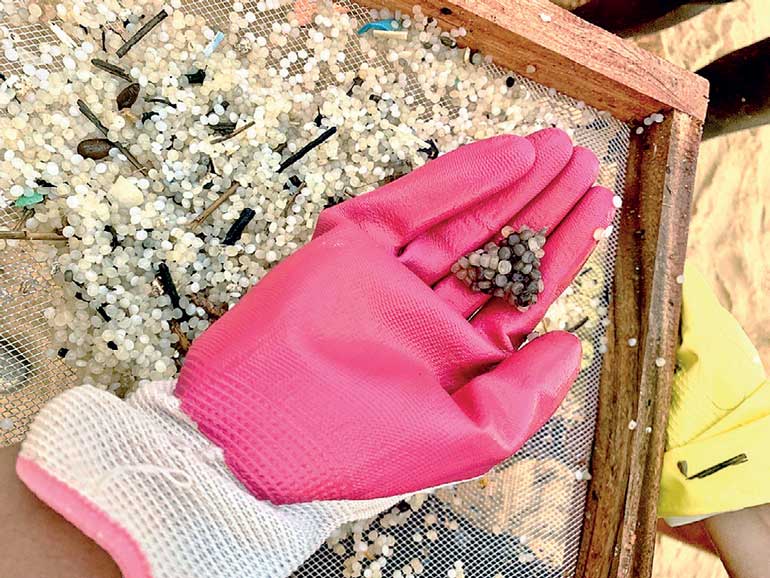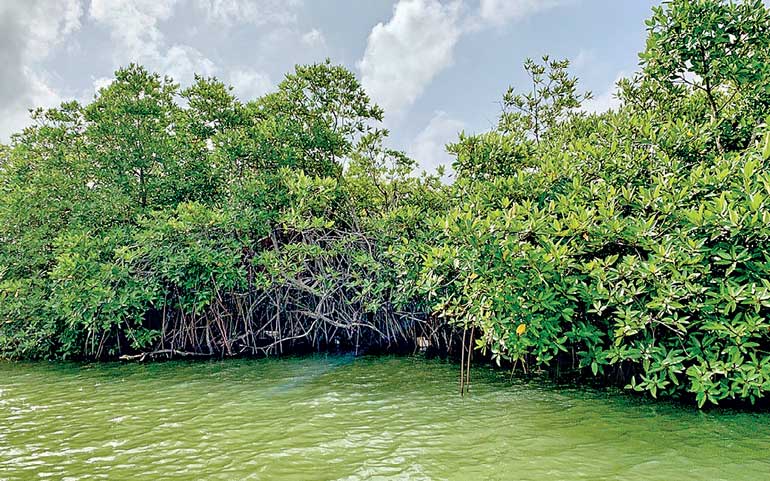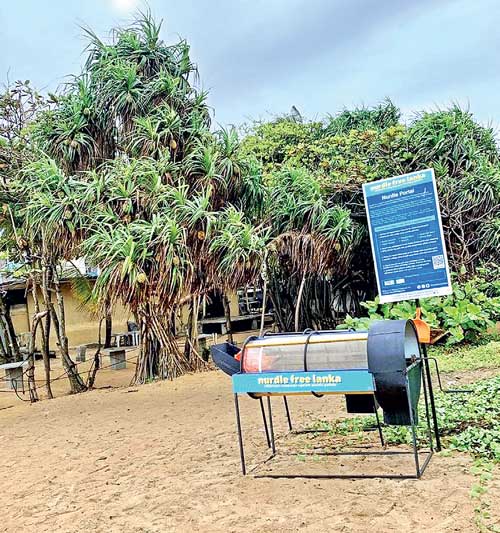Tuesday Apr 22, 2025
Tuesday Apr 22, 2025
Tuesday, 14 September 2021 00:50 - - {{hitsCtrl.values.hits}}

A cluster of nurdles which melted together found at Mount Lavinia beach during the
volunteer mobilisations for Nurdle Free Lanka – Image credit: Maleesha Gunawardana
The economic impact 
As of August 2021, the economic impact of the X-Press Pearl wreckage is yet to be fully understood due to the prevailing COVID-19 situation on the island and the lack of monitoring of the overall impact on economic activities in the country.
The fisheries sector was already suffering as a result of the pandemic restrictions, this shipwreck is an added setback. With regards to the seafood export industry in Sri Lanka, certain developments can be attributed to the marine disaster such as potential long term impacts on fish stocks. Several countries had expressed concerns over the safety of consuming fish from the waters of Sri Lanka due to the chemical pollution from the shipwreck.
According to the Secretary of the Seafood Exporters Association of Sri Lanka (SEASL), 5-7% of the seafood export industry has been affected due to restrictions in place for fishing shallow water fish while also highlighting that there has been no impact on tuna fisheries within the export industry. There are potential long-term impacts on fish breeding grounds which could result in lower yields of crabs and jumbo prawns which are sought after delicacies of foreign tourists. As a result of the shipwreck, eight out of 15 tourist zones on the coast are losing their attraction due to continuous chemical, plastic and other debris pollution washing ashore.
There are concerns over the long term impact on marine tourism in Sri Lanka, especially with regards to marine tours to observe sea mammals such as dolphins and blue whales. Due to the pollution from the ship, experts are predicting that declining water quality may cause cetaceans to leave Sri Lankan waters over time. Furthermore, as a result of the increasing marine fauna carcasses washing up on the shore, there could be unseen impacts on juveniles leading to a decrease in certain species of marine fauna. These impacts on marine life in Sri Lankan waters could have detrimental impacts on the tourism industry in the coming years.
The Sri Lankan Government received Rs. 720 million as initial compensation from the Shipwreck and Rs. 420 million of that was reserved for the affected fishing community. Before receiving the above-mentioned compensation, the Sri Lankan Government identified 9883 fishing families that were affected and allocated an initial total sum of Rs. 49,415,000 as compensation. Through this fund, Rs. 5,000 was allocated to each of these families. Negombo lagoon supports generational fishing communities, who were heavily affected following the immediate aftermath of the wreckage but some fishermen have already received compensation.

Floating nurdles were observed on the Negombo Lagoon which comprises a vast coastal mangrove ecosystem – Image credit: Avishka Sendanayake
The social impact 
The social impact caused as a result of the MV X-Press Pearl disaster is yet to be fully understood. As a result of the prevailing COVID-19 restrictions in Sri Lanka, the social impact from the accident alone is difficult to determine. However, there is evidence of fishing communities being affected throughout the Western and North-Western Provinces. In the Western Province alone, 7753 fishing families faced a loss of income following the disaster, while 2130 families that were involved in drying fish and fish netting also experienced a loss of income.
To date (August 2021), there is no evidence to state that the consumption of seafood from the waters surrounding the accident will not present negative health impacts on humans. Due to the lack of releasing the water test results as it is evidence for an ongoing court case, the general public is yet to know the safety of our waters. The presence of nurdles in seafood has caused many to be concerned about consuming local fish, which has also impacted the fishing communities. The Sri Lankan authorities have classified the nurdles as hazardous material as a result of the toxic nature of the nurdles and the chemical pollution from the ship.
Research suggests that the chemicals in microplastics have the potential to cause human health impacts. There have been several global studies that have identified potential chemical and physical impacts of microplastic on human health. Some of the physical impacts on the human body could be enhanced inflammatory response and disruption of the gut microbiome. There is still ongoing research to understand these impacts better.
Chemical additives in microplastics have potential negative impacts on human health, while it is also in the research phase, a significant correlation between BPA (Bisphenol A) levels in the urine and both cardiovascular disease and type 2 diabetes has been found. Humans are exposed to BPA through microplastics (low dose exposures) as well as non-microplastic sources (low and high dose exposures) from air and ingestion of food.
Many Sri Lankans expressed concerns over the safety of consuming salt as many of the industrialised salt pans are situated in the North Western Province, due to the pollution released from the ship as it was in close proximity. However, the private sector salt company named Raigam, released a statement, highlighting the safety of the salt for human consumption.
Legal implications
Several domestic and international legal instruments provide rights and liabilities to the parties involved; namely the shipowner (X-Press Feeders), flag state (Singapore), port state (Sri Lanka) and the charterer.
MEPA is the apex body that is responsible for the prevention, control and management of marine pollution in Sri Lanka; as well as the enforcing Government Entity for the provisions stipulated by the Marine Pollution Prevention Act No. 35 of 2008 (MPPA).
The provisions stipulated by the MPPA provide the following rights and liabilities:
nSection 22 – requires every ship that enters the territorial waters of Sri Lanka to “carry record books relating to oils, harmful substances or any other pollutants.”
nSection 23 – requires every ship entering the territorial waters of Sri Lanka to be “fitted with such equipment for the prevention of the discharge of oil, harmful substances or any other pollutant as may be prescribed” and imposes liability on “any owner, operator, master or agent of a ship who contravenes the provisions of this section” to be “guilty of an offence under this Act and shall on conviction be liable to a fine”.
nSection 24 – sets out the steps to be taken when there is a maritime casualty which is defined as, “a collision of ships, standing or other incident of navigation or other occurrence onboard a ship or external to it resulting in material damage or imminent threat of material damage to a ship or its cargo.”
nSection 34 (civil liability) – owner or operator of the ship shall be liable for the damage caused by the discharge or escape of harmful substances within a maritime zone of Sri Lanka.
nSection 26 (criminal action) – the owner, operator, master or the agent of the ship shall be liable for any discharge of harmful substances from a ship into a maritime or coastal zone or fore-shore of Sri Lanka.
Other examples of domestic Parliamentary Legislation that may apply include the Sri Lanka Ports Authority Act, No. 51 of 1979 (as amended), the Coast Conservation and Coastal Resource Management Act, No. 57 of 1981 (as amended), the National Environmental Act, No. 47 of 1980 (as amended) the Flora and Fauna Protection Ordinance, No. 2 of 1937 (as amended), the Maritime Zones Law, No. 22 of 1976 and the Department of Coast Guard Act, No. 41 of 2009.
At the same time, the flag state is bound by several international conventions. Both Sri Lanka and Singapore ratified the United Nations Convention on the Law of the Sea (UNCLOS) 1982 back in 1994 and are state parties to the International Convention for the Prevention of Pollution from Ships (MARPOL) 1973 as amended. Both countries have also acceded to the International Convention for the Safety of Life at Sea (SOLAS) 1974.
The provisions set out by the following Articles under Part II and XII of UNCLOS may be applicable.
Following the MV X-Press Pearl disaster, MEPA instituted a lawsuit against X-Press Feeders on behalf of the Central Government of Sri Lanka (GoSL), by means of the Attorney General's Department of Sri Lanka (AGDSL) which is currently ongoing. In addition, an Inter-Ministerial Steering Committee of senior government officials was established by the Cabinet of Ministers for overall coordinated response to the matter. Accordingly, Five Sub-Committees comprising legal action, compensation claims, environmental impacts, fisheries impacts and economic damages were formulated under the guidance of the Ministry of Justice (MoJ).
Several public interest litigation cases have also been instituted in the aftermath of the disaster. The Centre for Environmental Justice (CEJ), an environmental conservation and public interest litigation organisation in Sri Lanka, filed a fundamental rights petition in the Supreme Court of Sri Lanka to seek justice for the social and environmental damage caused.
Damage control
Cleaning up nurdles is an uphill task and unless they are physically removed they will become part of the estimated 51 trillion microplastics that are littering the ocean. Mitigation efforts in terms of cleanup were especially challenging due to the COVID-19 Containment Measures that were in place at the time, as well as the risk of chemical exposure at the shoreline which was the epicentre of the disaster.
The Marine Environment Protection Authority (MEPA) together with the Sri Lanka Armed Forces, the Sri Lanka Police and other Government Entities took up the task of restoring the worst-hit areas along the coast of Negombo, which in the immediate aftermath appeared to be coated in plastic snow due to the billions of nurdles that had washed ashore. As of 14 July 2021, MEPA has collected 1,600 metric tonnes of nurdles and other debris.
Moreover, in early August 2021, MEPA confirmed that there was an oil sheen emanating from the shipwreck and that they are mechanically dispersing the oil sheen for speedy evaporation. The oil sheen was observed to be spread across 1 NM (approximately 1.9 kilometres) away from the ship. MEPA also added that using chemicals to disperse the oil is not a possible solution due to the existing chemical pollution surrounding the ship. An oil spill prevention mechanism is in a position close to the wreckage which includes containment booms through Oil Spill Response Ltd., which is an organisation appointed by the shipowners to control potential future oil spills from MV X-Press pearl.
After some of the COVID-19 Containment Measures were lifted, volunteer groups and citizens came forward to assist the collection of nurdles. The Pearl Protectors, a youth-led marine conservation group, launched the ‘Nurdle Free Lanka’ volunteer campaign to help tackle the nurdle-strewn beaches. The group uses three tools to effectively filter the nurdles embedded in the sand. As of August 2021, the group has collected 872 kg of nurdles over six volunteer mobilisations across four beaches in the Western Province. The group has also placed ‘Nurdle Portals,’ starting with the Mount Lavinia and Dehiwala beaches, where the nurdle tools will be available at any time to be borrowed by anyone from the Coast Guard Points.
The way forward
August 2021 marks over three months since the disaster but there are many data and information gaps regarding key aspects of the shipwreck and the aftermath. The general public in Sri Lanka is awaiting the official test results from the water tests and the necropsy test results of the dead marine wildlife.
Moreover, an assessment of the sensitive benthic ecosystems comprising coral reefs is essential, with one of the many reasons being that such ecosystems and marine wildlife play a key role in Sri Lanka’s tourism industry. There also exists a need to alleviate the public concern over seafood safety by assessing the chemical and microplastic contaminants in seafood in the areas that were impacted by the spills that emanated from the vessel by disseminating a comprehensive report to the public.
Several immediate steps need to be taken by the Central Government of Sri Lanka (GoSL), starting with addressing the existing legal loopholes that surfaced in the aftermath of the disaster. While Sri Lanka has strong legal provisions which can be used to claim compensation and remove the shipwreck from the immediate territorial waters, legislation that can be used is dependent upon the legal authority that is taking the lead on the incident. Therefore, it is important that the Marine Pollution Prevention Act is updated and strengthened to provide a legal base for similar maritime disasters in the future.
The ongoing disaster has yet again emphasised the need to further strengthen Sri Lanka’s maritime disaster management capacity. While Sri Lanka has a contingency plan to tackle oil spills, there is no chemical contingency plan in place. Minimising nurdle spills, however, would require changes to international maritime regulations to ensure that nurdles are packaged, stored and transported with high precaution.
Against this global backdrop, being a country that has experienced what’s considered as one of the largest nurdle spills, Sri Lanka can effectively advocate towards reviewing the existing regulations by documenting the impacts and the need for prevention at the source. To build on a stronger maritime disaster management plan, it is essential to review the existing international maritime conventions, accede to those that are in the best interests of Sri Lanka and update domestic laws accordingly.
Furthermore, it is imperative that Sri Lanka promotes the need for interagency communication, removal of overlapping mandates and strengthening cooperation between government entities that are relevant for a marine disaster at any scale. Lack of data transparency and accountability is a major hindrance to achieving good governance in Sri Lanka. Since Sri Lanka is committed to achieving the Sustainable Development Goals (SDGs), prioritising SDG 16 which addresses good governance, could transform the country and lead to lasting prosperity.
(The writers can be contacted via [email protected] and [email protected])
Discover Kapruka, the leading online shopping platform in Sri Lanka, where you can conveniently send Gifts and Flowers to your loved ones for any event including Valentine ’s Day. Explore a wide range of popular Shopping Categories on Kapruka, including Toys, Groceries, Electronics, Birthday Cakes, Fruits, Chocolates, Flower Bouquets, Clothing, Watches, Lingerie, Gift Sets and Jewellery. Also if you’re interested in selling with Kapruka, Partner Central by Kapruka is the best solution to start with. Moreover, through Kapruka Global Shop, you can also enjoy the convenience of purchasing products from renowned platforms like Amazon and eBay and have them delivered to Sri Lanka.
Discover Kapruka, the leading online shopping platform in Sri Lanka, where you can conveniently send Gifts and Flowers to your loved ones for any event including Valentine ’s Day. Explore a wide range of popular Shopping Categories on Kapruka, including Toys, Groceries, Electronics, Birthday Cakes, Fruits, Chocolates, Flower Bouquets, Clothing, Watches, Lingerie, Gift Sets and Jewellery. Also if you’re interested in selling with Kapruka, Partner Central by Kapruka is the best solution to start with. Moreover, through Kapruka Global Shop, you can also enjoy the convenience of purchasing products from renowned platforms like Amazon and eBay and have them delivered to Sri Lanka.